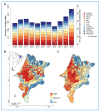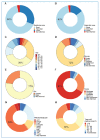Snakebites in Northeastern Brazil: accessing clinical-epidemiological profile as a strategy to deal with Neglected Tropical Diseases
- PMID: 37820102
- PMCID: PMC10561396
- DOI: 10.1590/0037-8682-0224-2023
Snakebites in Northeastern Brazil: accessing clinical-epidemiological profile as a strategy to deal with Neglected Tropical Diseases
Abstract
Background: Brazil ranks first in the number of snakebites in South America. A detailed analysis of these cases is required to improve the public health planning. In this study, we retrospectively examined the clinical and epidemiological profiles of snakebites in Maranhão between January 2009 and December 2019.
Methods: Data were obtained from the compulsory notification forms provided by the Health Department of Maranhão.
Results: A total of 17,658 cases were recorded during the study period. Most of the bites were from snakes belonging to the genus Bothrops. Medical care was mostly within three hours after the bite. Most cases were classified as mild and most victims recovered; however, 139 deaths were recorded. Most bites occurred among people aged 20-39 years, mainly among rural workers. The most frequent local clinical manifestations were pain, edema, and ecchymosis. The most common systemic clinical manifestations include neuroparalysis, vagal syndrome, and myolysis. Most snakebites occurred between January and March. The municipalities with the highest number of notifications were Buriticupu (936 cases), Arame (705 cases), and Grajaú (627 cases).
Conclusions: The clinical profile of snakebites in Maranhão is similar to that observed in other states of Northeast Brazil. However, we found that some systemic manifestations are not compatible with the etiology of snakebites, which leads us to believe that the problem could be the lack of knowledge of the health professionals at the site of envenomation, who may not be ready for attendance, and an important lack of health centers with snake antivenom to treat snakebites.
Conflict of interest statement
Figures



References
-
- World Health Organization (WHO) Snakebite envenoming. Geneva: WHO; 2021. [2021]. Disponível em: https://www.who.int/health-topics/snakebite#tab=tab_1 .
-
- Citeli N, Carvalho M, Carvalho BM, Magalhães MAFM, Bochner R. Bushmaster bites in Brazil: ecological niche modeling and spatial analysis to improve human health measures. Cuad herpetol. 2020;34(2):00–00.
MeSH terms
Substances
LinkOut - more resources
Full Text Sources

